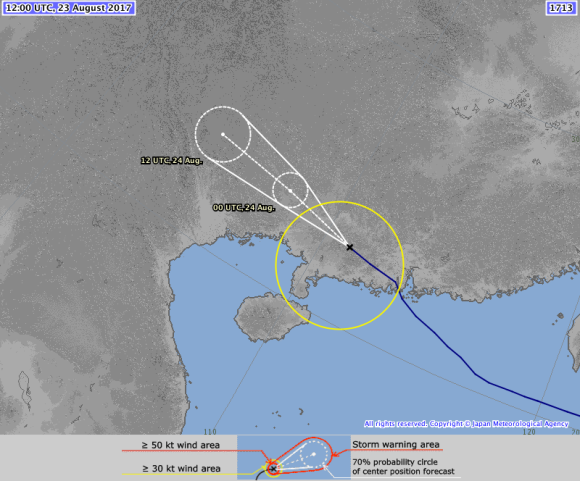Typhoon Hato
Status: Closed
| Type of posting | Posting date(EST): | Summary | Downloads |
|---|---|---|---|
| Post Landfall 1 | 8/28/2017 5:30:00 AM |
|
|
| Landfall | 8/23/2017 7:45:00 AM |
|
Landfall | Summary
Posting Date: August 23, 2017, 7:45:00 AM
Hato, the 13th typhoon to form in the northwest Pacific Basin this year, made landfall midday local time in the city of Zhuhai between Hong Kong and Macau in Guangdong Province. It is the seventh typhoon to impact China this year, and the strongest since Typhoon Vicente in 2012. In Macau, gusts of 132 mph have been reported. The center of the storm passed about 37 miles south of Hong Kong with maximum sustained winds of 78 mph and heavy rain. At least five people have been killed in Macau and one in Hong Kong.
Ahead of the storm, the government opened 27 shelters across Hong Kong and about 4,000 coastal residents were evacuated. Hundreds of flights were canceled, rail and ferry services were suspended, several expressways were closed, operations for parts of the subway system in Shenzhen were halted, and fishing vessels were recalled to port. Factories, courts, schools, and offices closed, and the stock exchange ceased trading.
Exposure at RiskThe city of Guangzhou is the economic center of the Pearl River Delta and is at the heart of one of mainland China's leading commercial and manufacturing regions. Hong Kong is currently home to more than 7 million people. When compared to other coastal areas in the South China Sea, Hong Kong’s mountainous coastline and strongly enforced building codes lessen wind vulnerability. Its heavy investment in a flood defense system keeps inland flood risk within the city relatively low, although flooding is common in the surrounding areas and particularly in the mountainous regions. The reclamation of land is increasing storm surge vulnerability in the region due to the proximity of exposure to sea level and the narrowing of Victoria Harbour. Most of the single-family houses in Hong Kong are made of reinforced masonry or concrete. Condominiums and commercial and industrial buildings—often mid- or high-rise structures—are mainly made of reinforced concrete or steel, reducing wind vulnerability. However, many high-rise buildings have basements where service equipment is located; this kind of equipment is expensive and vulnerable to water damage.
Reported ImpactHong Kong braced itself for 6- to 10-hours of severe weather on Wednesday. Initial reports note power outages and disruption to mobile phone and internet networks. Much of Macau lost power for two hours. Wind damage includes roof and siding damage, blown out windows, and hundreds of fallen trees. On Hengqin Island in Zhuhai, a construction crane was blown from the top of an unfinished high rise building.
As well as strong winds, Hato is delivering heavy precipitation, with 10 cm to 25 cm per hour reported in some southern parts of Guangdong and Guangxi. Because the system is moving rapidly the damage from heavy precipitation will be limited, but widespread flooding is nevertheless expected in its wake as Hato moves inland. In Guangzhou, Yangjiang, Zhenjiang, Nanning, and Wenshan motorists have been warned to expect road closures and damaged bridges. Maximum storm surge was about 1.1 meters and coincided with high tide. Coastal flooding from inundating storm surge, especially in low-lying areas facing east and south, has been reported with buildings and vehicles swamped.

Forecast track for Typhoon Hato issued 12:00 UTC, August 23. (Source: JMA)
Forecast Track and Intensity
In Hong Kong, the courts, financial markets and businesses are set to resume normal activity on Thursday. Hato will continue to track west-northwest as a tropical storm, delivering widespread rainfall across western Guangdong, southern Guangxi, and Yunnan provinces, and into northern Vietnam. As well as flooding, the widespread rainfall may trigger mudslides.